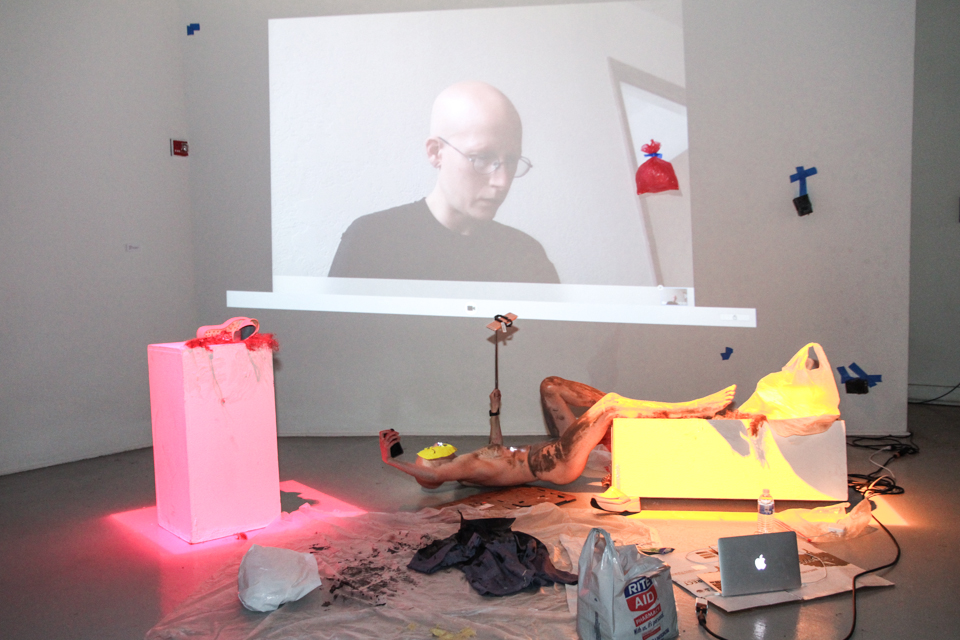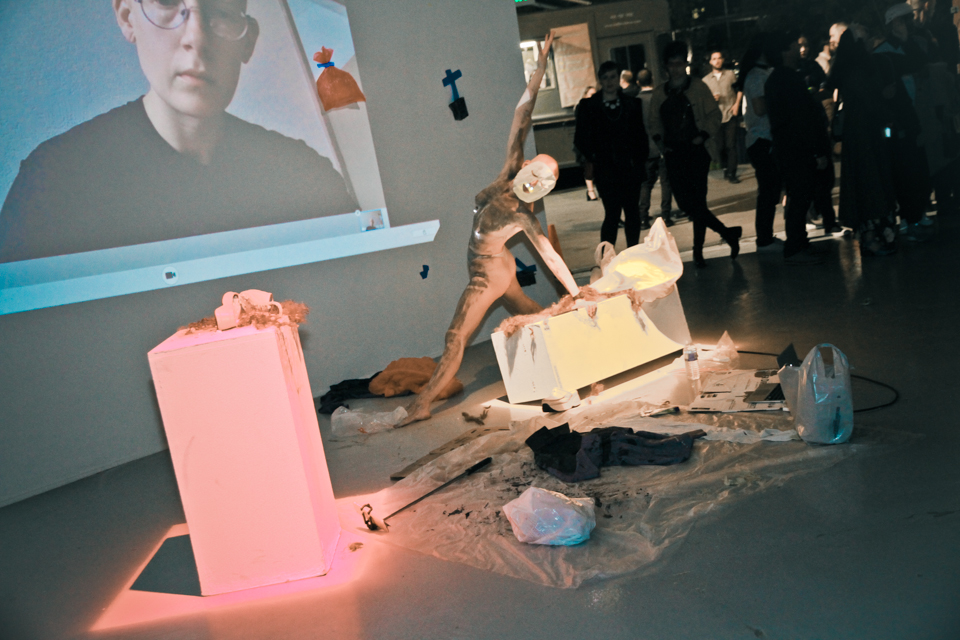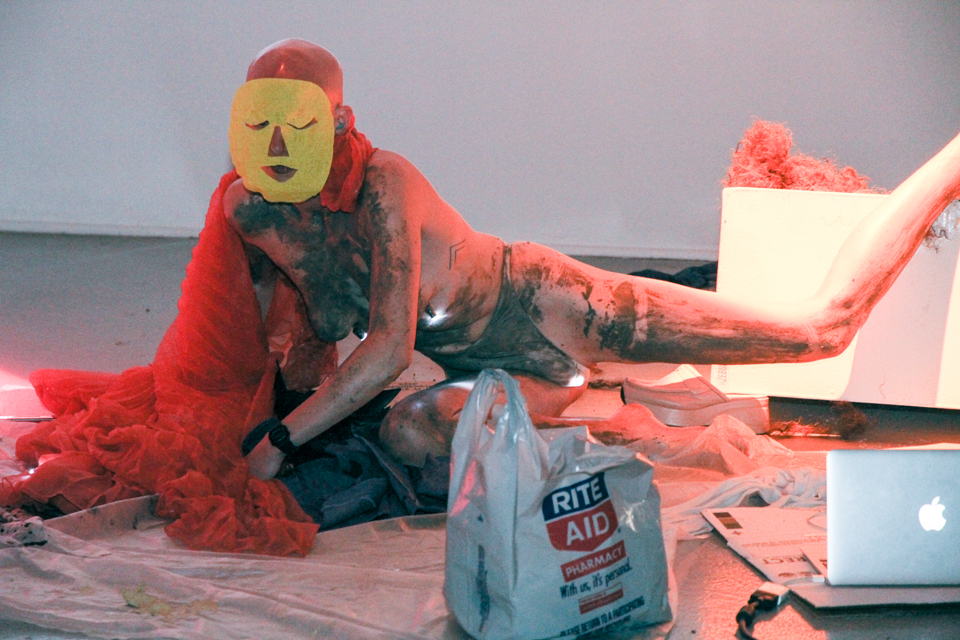

My name’s Dia Dear. I’m an untraditionally trained dancer, choreographer, performance, and visual artist and make live, solo work. My work grew out of drag clubs and queer nightlife in San Francisco. My practice is most closely rooted in the open-ended concept encapsulated by notions of ‘queerness’.
I’m working on an evening length piece that will premiere at CounterPulse in February 2018 investigating tension. In preparation for that piece, I’m making images that generate the most and least tension.
A couple of years ago, I began reflecting in a very focused way on what I made and was interested in making. Tension as a concept slowly revealed itself as a primary concern and interest for me. Tension is a force, push and pull at once. Incongruent and interlocked. It’s a pendulum that swings between varying degrees of tightness and release. Tension is the experience of events coming into sharper focus. It is energies that are dense, unsustainable, combustible. Things that quickly change.
Specifically I saw tension in my work in the creation of drama; in the jerky, isolation dancing I was drawn to choreographing; in the conflicted emotional content of my pieces existing in a messy state where feelings are tied to desire, ego, context, history; in displaying my rare form of alopecia and transgender body openly.

I saw tension as a theme of my lived experience too. It’s something I’ve been trying to write about: how the condition of tension is related to transgender bodies, diseased bodies, and any body marked with visible physical differences that are pathologized. It’s even more interesting and complicated to me to look at how these bodies in performance art are valued, and how the meanings the bodies are imbued with – which Other them – can be reclaimed and used as collateral or appropriated and made into art capital.
I also noticed how literal physical tension affects my body—I have a horrible problem with my jaw that can make it painful to open my mouth, and have had inflammation problems with both knees that greatly affected my mobility. Then of course there is psychological tension, emotional tension, any other tension a human body can experience.
Now, I think about tension and its value in body based art a lot. I’m interested in using all the body’s potential (in my work that has been my own body) as a tool for translation. The body has the potential to translate through movement and manipulation of physical appearance. In my short format work in clubs, manipulating the appearance of the body to create spectacle is an important tool to attract and maintain attention in an overstimulating environment. I also believe creating spectacle is a useful way to destabilize a viewer’s experience or tendency to ‘read’ a body as this or that. Spectacle, however, is becoming a major way of communicating. Social media algorithms prime spectacular content to be most visible, most consumed, and most commodified. I think about how that is culturally changing people, and the position that puts the artist using body and movement in their work.
These reflections turned into a focus on the physical manifestations of tension in a body on a stage. I made choreographies of tension throughout 2016 and showed my work on tension in the performing body at SOMArts as a part of the curated group show Touch On (December 2016 – January 2017).

The second phase of my tension work has me thinking about tension in terms of images and the process of making images. Images seem not to exist without a viewer so I’m thinking of the viewer’s experience as I fabricate tension in images.
I was just flicking through a dating app with my friend on her couch a night ago as a way to decompress. Watching her flick through her own app and NO and YES people was a reminder of how image reading works. With my friend, knowing her type, I was surprised when she would say NO to some people and YES to others. This reminded me that everyone looks at an image and interprets it uniquely. It makes sense to me to think about image interpretation as a form of reading and the unique way each person interprets an image as indicative of a personal language. Everyone has their own language for reading and is a skilled reader before they are ever a competent maker of images. Everyone has their own language of reading images that can’t easily be translated to another. When reading written text in a language you have fluency, the reader’s comprehension can get very close to the intended meaning of the writer if the writing is done skillfully with the intention of being unambiguous. Image reading cannot achieve that clarity. Culturally, familially we are bombarded with information about how the meaning of images interacts with that individual’s lived experience and history. And as individuals we create some of our own meaning and it all jumbles together into something that’s not wholly conscious. So, I’m interested in reading images for what generates interest and what doesn’t generate interest. I’m making a collection of images in response to this research.
I want a break from tension too and am thinking about, not it’s complement (release) but it’s absence: ease.
I’ve been trying to read an essay by Susan Sontag where she discusses silence in art and uses one of my favorite painters to discuss the principle: Agnes Martin. Sontag’s language in this essay is relatively dense compared to her later work that I’ve read, and it’s hard for me to follow her in this essay. I quickly get frustrated or tired and stop reading. What I gather from Sontag and from studying Martin’s paintings in real life is a sense of quiet that isn’t silencing. It isn’t trying to ‘do’ anything. It’s completely unaggressive but utterly powerful. It’s an openness. Martin’s paintings are famously difficult to reproduce because she used very faint color. They’re large and square so when you stand in front of them they feel big enough to hold you but not so big as to be unrelatable. They’re simple: collections of grids and lines with little to no variation in a single painting. They possess a depth of field and meaning that is contradictory, but sort of similar to the work of some religious traditions that are used for meditation. Except in her paintings there is no focal point to meditate on. It’s just one big whole.
I’m interested in finding that performative / body based corollary. That’s where I’m at right now and I’ll leave it there because I don’t have the research yet to say anything more. In the next year, I’ll be presenting more work in preparation for the tension premiere at CounterPulse and continuing sharing writing on some of the topics I touched on here. If you’re interested in staying updated on the piece, please send me an email at dia@diadear.com and let me know!


